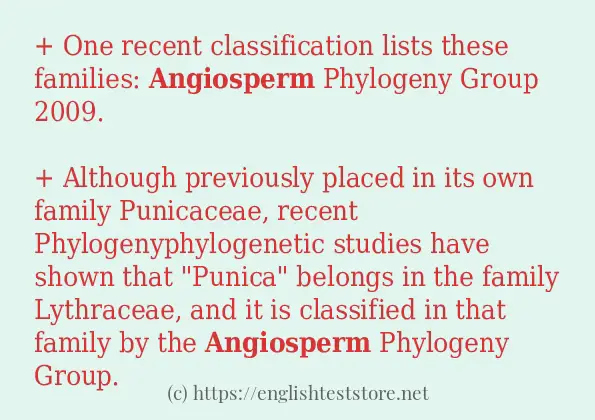How to use in-sentence of “angiosperm”:
+ One recent classification lists these families: Angiosperm Phylogeny Group 2009.
+ Although previously placed in its own family Punicaceae, recent Phylogenyphylogenetic studies have shown that “Punica” belongs in the family Lythraceae, and it is classified in that family by the Angiosperm Phylogeny Group.
+ Leea, sometimes classified in its own family, Leeaceae, is included in Vitaceae by the APG and the Angiosperm Phylogeny Web.
+ An update of the Angiosperm Phylogeny Group classification for the orders and families of flowering plants: APG IV.
+ The Crossosomatales are an order, newly recognized by the Angiosperm Phylogeny GroupAGP II, of flowering plants, included within the Rosids, which are part of the eudicots.

Example sentences of “angiosperm”:
+ The Angiosperm Phylogeny Group treats Fabaceae in the broad sense.
+ The fertilized angiosperm ovule develops into a seed, and the ovary develops into the fruit.
+ Pollen probably of angiosperm origin takes the fossil record back to about 130 mya.
+ Insights into the dynamics of genome size and chromosome evolution in the early diverging angiosperm lineage Nymphaeales.
+ The oldest reported age for an Angiosperm tree is 2,305 years for the Sri Maha Bodhi sacred fig planted in 288BC at Anuradhapura, Sri Lanka; this is said to be the oldest human-planted tree with a known planting date.
+ As circumscribed by Angiosperm Phylogeny GroupAPG II-system, it includes about 6000 species within nine families.
+ Botanists think it is the most basal plant in the angiosperm clade.
+ The family was placed in the Rosid clade, but not classified in an order, by the Angiosperm Phylogeny Group.
+ Amborella trichopoda — cultivation of the most ancestral angiosperm in botanic gardens.
+ The Angiosperm Phylogeny Group treats Fabaceae in the broad sense.
+ The fertilized angiosperm ovule develops into a seed, and the ovary develops into the fruit.
+ Pollen probably of angiosperm origin takes the fossil record back to about 130 mya.
+ The phylogeny of Angiosperms is as follows: Angiosperm Phylogeny Group 2003.
+ However, in the modern APG III system of classification, Angiosperm Phylogeny Group 2009.
+ The Angiosperm Phylogeny Group’s APG II classification places Agavaceae, along with a number of other families in an expanded family Asparagaceae.
+ An update of the Angiosperm Phylogeny Group classification for the orders and families of flowering plants: APG III.
+ Earlier angiosperm classifications were not based on monophyletic groups.
+ An update of the Angiosperm Phylogeny Group classification for the orders and families of flowering plants: APG II.
+ The Angiosperm Phylogeny Web places Vitaceae in its own order, Vitales.
